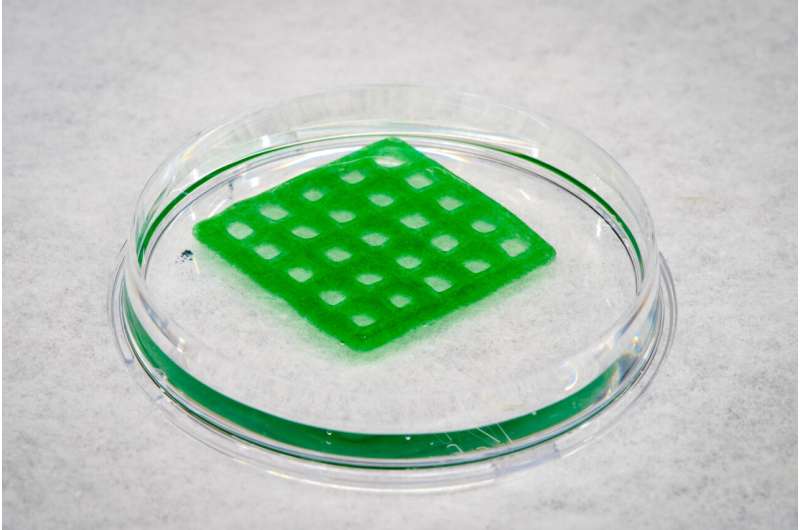This article has been reviewed according to Science X's editorial process and policies. Editors have highlighted the following attributes while ensuring the content's credibility:
fact-checked
peer-reviewed publication
trusted source
proofread
3D-printed 'living material' could clean up contaminated water

Researchers at the University of California San Diego have developed a new type of material that could offer a sustainable and eco-friendly solution to clean pollutants from water.
Dubbed an "engineered living material," it is a 3D-printed structure made of a seaweed-based polymer combined with bacteria that have been genetically engineered to produce an enzyme that transforms various organic pollutants into benign molecules. The bacteria were also engineered to self-destruct in the presence of a molecule called theophylline, which is often found in tea and chocolate. This offers a way to eliminate them after they have done their job.
The researchers describe the new decontaminating material in a paper published in Nature Communications.
"What's innovative is the pairing of a polymer material with a biological system to create a living material that can function and respond to stimuli in ways that regular synthetic materials cannot," said Jon Pokorski, a professor of nanoengineering at UC San Diego who co-led the research.
The work was a collaboration among engineers, materials scientists and biologists at the UC San Diego Materials Research Science and Engineering Center (MRSEC). Co-principal investigators of the multidisciplinary team include molecular biology professors Susan Golden and James Golden and nanoengineering professor Shaochen Chen.
"This collaboration allowed us to apply our knowledge of the genetics and physiology of cyanobacteria to create a living material," said Susan Golden, a faculty member in the School of Biological Sciences. "Now we can think creatively about engineering novel functions into cyanobacteria to make more useful products."
To create the living material in this study, the researchers used alginate, a natural polymer derived from seaweed, hydrated it to make a gel and mixed it with a type of water-dwelling, photosynthetic bacteria known as cyanobacteria.
The mixture was fed into a 3D printer. After testing various 3D-printed geometries for their material, the researchers found that a grid-like structure was optimal for keeping the bacteria alive. The chosen shape has a high surface area to volume ratio, which places most of the cyanobacteria near the material's surface to access nutrients, gases and light.
The increased surface area also makes the material more effective at decontamination.
As a proof-of-concept experiment, the researchers genetically engineered the cyanobacteria in their material to continually produce a decontaminating enzyme called laccase. Studies have shown that laccase can be used to neutralize a variety of organic pollutants including bisphenol A (BPA), antibiotics, pharmaceutical drugs and dyes.
In this study, the researchers demonstrated that their material can be used to decontaminate the dye-based pollutant indigo carmine, which is a blue dye that is widely used in the textile industry to color denim. In tests, the material decolorized a water solution containing the dye.
The researchers also developed a way to eliminate the cyanobacteria after the pollutants have been cleared. They genetically engineered the bacteria to respond to a molecule called theophylline. The molecule triggers the bacteria to produce a protein that destroys their cells.
"The living material can act on the pollutant of interest, then a small molecule can be added afterwards to kill the bacteria," said Pokorski. "This way, we can alleviate any concerns about having genetically modified bacteria lingering in the environment."
A preferable solution, the researchers note, is to have the bacteria destroy themselves without the addition of chemicals. This will be one of the future directions of this research.
"Our goal is to make materials that respond to stimuli that are already present in the environment," said Pokorski.
"We're excited about the possibilities that this work can lead to, the exciting new materials we can create. This is the kind of research that can result when researchers with cross-disciplinary expertise in materials and biological sciences join forces. This is all made possible thanks to our interdisciplinary research group at the UC San Diego MRSEC."
More information: Debika Datta et al, Phenotypically complex living materials containing engineered cyanobacteria, Nature Communications (2023). DOI: 10.1038/s41467-023-40265-2
Journal information: Nature Communications
Provided by University of California - San Diego



















